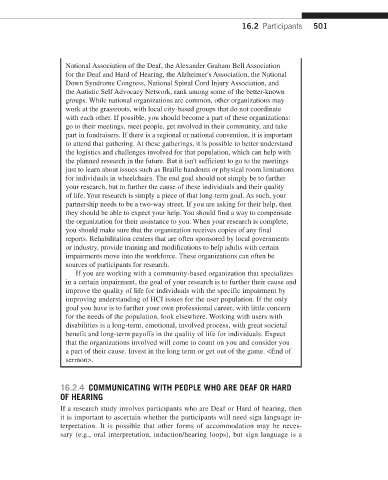Page 508 -
P. 508
16.2 Participants 501
National Association of the Deaf, the Alexander Graham Bell Association
for the Deaf and Hard of Hearing, the Alzheimer's Association, the National
Down Syndrome Congress, National Spinal Cord Injury Association, and
the Autistic Self Advocacy Network, rank among some of the better-known
groups. While national organizations are common, other organizations may
work at the grassroots, with local city-based groups that do not coordinate
with each other. If possible, you should become a part of these organizations:
go to their meetings, meet people, get involved in their community, and take
part in fundraisers. If there is a regional or national convention, it is important
to attend that gathering. At these gatherings, it is possible to better understand
the logistics and challenges involved for that population, which can help with
the planned research in the future. But it isn't sufficient to go to the meetings
just to learn about issues such as Braille handouts or physical room limitations
for individuals in wheelchairs. The end goal should not simply be to further
your research, but to further the cause of these individuals and their quality
of life. Your research is simply a piece of that long-term goal. As such, your
partnership needs to be a two-way street. If you are asking for their help, then
they should be able to expect your help. You should find a way to compensate
the organization for their assistance to you. When your research is complete,
you should make sure that the organization receives copies of any final
reports. Rehabilitation centers that are often sponsored by local governments
or industry, provide training and modifications to help adults with certain
impairments move into the workforce. These organizations can often be
sources of participants for research.
If you are working with a community-based organization that specializes
in a certain impairment, the goal of your research is to further their cause and
improve the quality of life for individuals with the specific impairment by
improving understanding of HCI issues for the user population. If the only
goal you have is to further your own professional career, with little concern
for the needs of the population, look elsewhere. Working with users with
disabilities is a long-term, emotional, involved process, with great societal
benefit and long-term payoffs in the quality of life for individuals. Expect
that the organizations involved will come to count on you and consider you
a part of their cause. Invest in the long term or get out of the game. <End of
sermon>.
16.2.4 COMMUNICATING WITH PEOPLE WHO ARE DEAF OR HARD
OF HEARING
If a research study involves participants who are Deaf or Hard of hearing, then
it is important to ascertain whether the participants will need sign language in-
terpretation. It is possible that other forms of accommodation may be neces-
sary (e.g., oral interpretation, induction/hearing loops), but sign language is a

